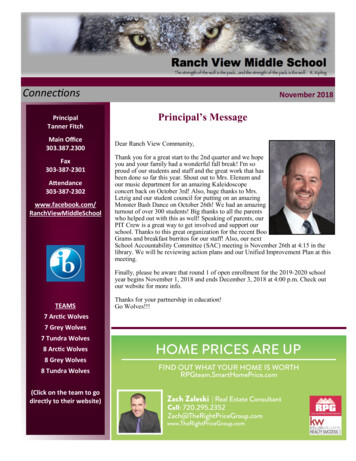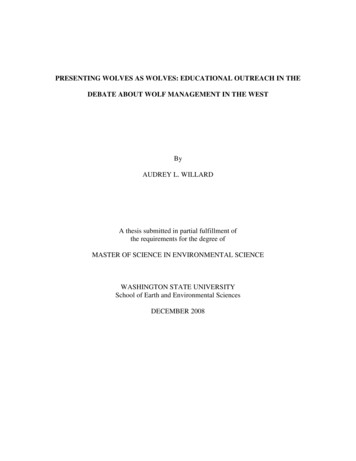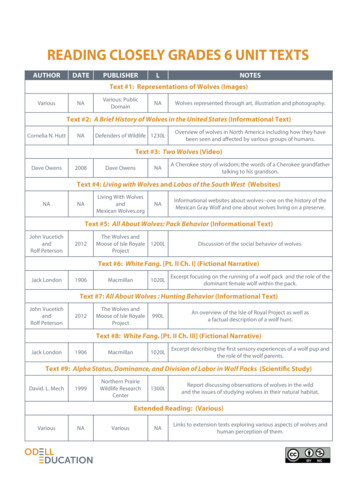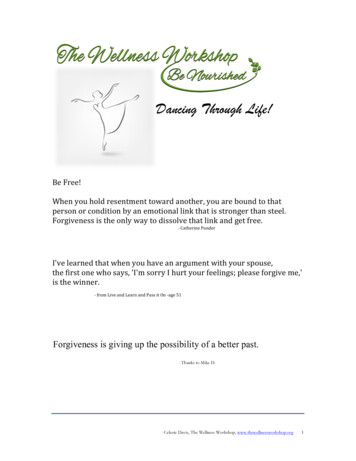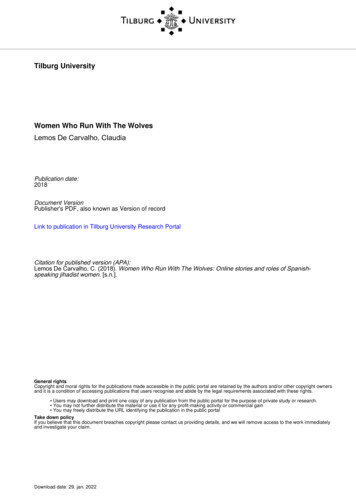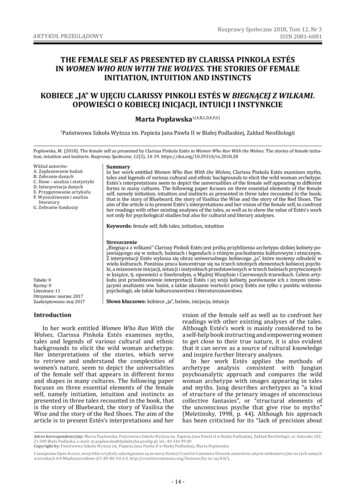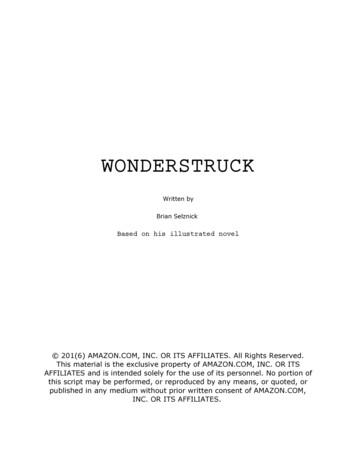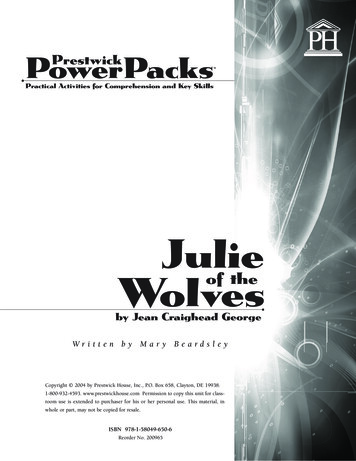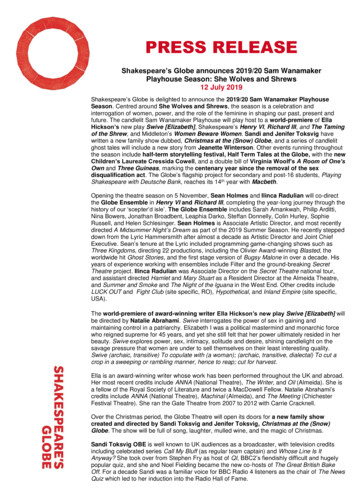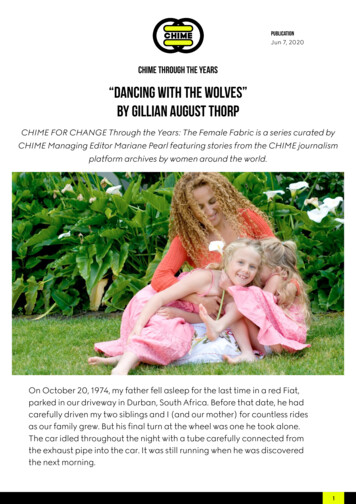
Transcription
PublicationJun 7, 2020CHIME THROUGH THE YEARs“Dancing with the Wolves”by Gillian August ThorpCHIME FOR CHANGE Through the Years: The Female Fabric is a series curated byCHIME Managing Editor Mariane Pearl featuring stories from the CHIME journalismplatform archives by women around the world.On October 20, 1974, my father fell asleep for the last time in a red Fiat,parked in our driveway in Durban, South Africa. Before that date, he hadcarefully driven my two siblings and I (and our mother) for countless ridesas our family grew. But his final turn at the wheel was one he took alone.The car idled throughout the night with a tube carefully connected fromthe exhaust pipe into the car. It was still running when he was discoveredthe next morning.1
“Dancing with the Wolves” by Gillian August ThorpIt was long after my father’s death that I would learn of the details. Hissuicide was kept a secret from us children. In my young mind it madeno sense that the man I loved most in this world would just suddenlydisappear. With confusion came dark shadows that loomed over me,and my family’s lives forever changed with his “disappearance.”I was four years old when he “left.” He had a tender heart and I can stillremember him telling me one day, “black, brown, white, boys, girls—weare all the same—we’re all just people Gillian.” But the tilted system ofapartheid and the haunted houses I would live in following his deathtold me otherwise.For years after my father’s death, my mother disappeared into a bottle,drinking her pain away. Unable to care for us, my siblings and I weresent to live on a remote farm. The adults called it “boarding school” butit was actually foster care.Mother’s vision blurred by grief and alcohol, she remarried a man whowas quick to beat my brother, and to leer at my sister and me. Withthis man in her life she felt she could now retrieve us. In a land wheremisogyny and patriarchy were engrained cultural norms, her newhusband acted like a hero and my family treated him as our “rescuer.”In reality, he was anything but that.We came to live with my mother and Marcel in a dreaded fortress ofabuse. He terrorized each of us with physical beatings and the sound ofhis belt striking my brother’s skin became a regular thrum that echoedthrough the house, along with my brother’s cries of pain and fear.The belt was reserved for my brother Thurn, the bamboo stick for mysister Tania and I, and his punches were for our mother. Though hisbeatings were frightful, nothing terrorized me more than hisnighttime visits.At eight years old I had no idea why I would awaken in the middle ofthe night to see him hovering over my side of the bed with his handson my body.2
“Dancing with the Wolves” by Gillian August ThorpThe moment I would wake, he would quietly disappear into the dark,leaving me in a world of confusion and fear. I would wonder: “Why washe here? What was he doing to my body? Why did he hate me so muchto do this to me?” Filled with fear I would mummify my body each nightas I tightly wrapped myself in blankets.As I look back, there were tears shed in secret, born of pain and muchisolation. I felt that there was no one I could turn to because in suchan environment where could I go for help? I was a poor coloured girlwhose mother drank her problems away and I was more her caretakerthan she was mine. There were no hotline numbers to call, nocounselors at school to talk to, no sex education classes or teachingsat all about such matters. “Children spoke when they were spoken to,and seen but not heard,” were repeated phrases from adults.School was no safe haven either, as teachers frequently hit studentswith sticks and rulers. In the sewing class that was required teachingfor girls, I was hit on my knuckles for having a single stitch out of placeon my apron. My trust in the world at large was tainted, and I kept myconfusion to myself.In 1986, South Africa was in the throes of a cultural and societalrevolution. Outside of our house of fear and pain, clashes betweenthe various black consciousness movement groups and the apartheidregime were in full swing; violence was commonplace, civilian deaths,explosions, grenades, strikes, mass uprising, police brutality, nationwide state of emergencies, and bombings at hotels, grocery storesand other public places.The South African government attempted to murder my Uncle Nicki,whom I loved and admired for his courage. Although he was not aroundthe family often, due to him being either in exile or leading his comradeson secret missions to overthrow the white-controlled South Africangovernment.3
“Dancing with the Wolves” by Gillian August ThorpHe was a vibrant figure who regaled us with stories when we did seehim and his firm convictions filled a room the moment he entered it. In1986, Nicki was leading the Johannesburg branch of AZAPO (AzanianPeople’s Organization). My grandmother was worried for her family’ssafety given our uncle’s involvement in the revolution and she urged mymother and her husband to get us out of South Africa. Marcel decidedon California and my grandmother scraped together her life earnedsavings and bought us our one-way-tickets out of Africa.With one bag of clothes each and a few humble belongings; weunpacked our things in a studio apartment in Ventura, California –two adults and three teenagers. I was fourteen at the time and foundmyself in a culture that I neither fit into nor understood. In SouthAfrica, I belonged to the “coloured” community and never interactedwith white people (it was illegal to do so). I knew my place there butin America I had no idea where I belonged or how to act. It felt strangeliving next door to white people for the first time. Should I divert my eyeswhen they look at me? Do they know we aren’t supposed to live nextdoor to them?I tried to find my niche but it was rough going. With blonde hair, fair skin,green eyes (a vestige left behind from my great-grandmother’s Welshlover and the European soldier on my father’s side) and a South Africanaccent, I was foreign to blacks in America while, white people wereforeign to me. I found myself gravitating towards Mexicans. They hadbrown skin like a lot of coloured people, and I came to learn that a goodnumber were illegally present in the United States. We had commonground in this respect as my family and I were considered “illegal aliens”as well. I felt great isolation in America and I contemplated runningaway but there was nowhere to go. I thought of returning to SouthAfrica but I knew this was not a serious option I had no money, no joband my grandmother would have been heartbroken and probably evenangry with me if I ever returned. Plus I felt a huge responsibility to takecare of my mother, whose mental and emotional health had been indecline for a decade by this point.4
“Dancing with the Wolves” by Gillian August ThorpAfter a few years of living the secret and repressive life of illegal aliens,my family won the biggest lottery prize any alien can win – the GreenCard Lottery. We were granted permanent resident status and I nolonger had to fear being rounded up and thrown into the back of atruck and carted off to a holding cell or airport. There was a freedomthat came with our new status, and I suddenly saw endless possibility.Though the future looked bright, family secrets weighed heavy on me.We were living in Reno at the time and it was there that I confrontedmy sister for the first time about the sexual abuse at the hands ofMarcel. In all the years that we had shared a room, I never saw himdo anything to Tania and I had never talked to her about it. Aftermuch pleading, Tania confided in me what I had feared and made mepromise never to tell another soul. But I lied.This newfound information would not let me be silent any longer. Ialready hated him for what he had done to my mother, brother andme, but this was the last straw. The sheer anger and fury took overand I could no longer contain it. I was about nineteen at the time,and a family gathering brought my grandmother to America (for thefirst time) to witness our immigrant success story – my family owneda house, Marcel’s business was thriving, we were now permanentresidents and each of us were working. I should have been happy buthappiness did not buzz inside me. It was at the family gathering that Iunexpectedly (even to myself) announced to everyone gathered whoMarcel really was and the horrific abuse we had suffered over the years.He stood across the house full of people and looked at me with thefamiliar crooked smile I had come to know so well. It was a cunningsmirk that never reached his eyes.I hated to look into those eyes; whenever he talked to me, I would lookaway. His eyes and smile were those of a dog before it bites. Usually hisface, particularly his eyes scared me.But for the first time I did not look away. I locked eyes with him and keptmy eyes fixed on his.5
“Dancing with the Wolves” by Gillian August ThorpHis smirk seemed less fearful and simply weak and revolting. My eyesremained fixed on his as anger flooded my body and I began totremble. His lips flattened into a thin line and he tilted his head, like adog perplexed by something it had never seen, and he turned away. Iwanted to spit all the bitter ashes of my childhood, our childhood intothose eyes, but something else happened instead.I realized at once that the laughter was a lie, the party was a lie, everyword that came out of his raucous, tight mouth for years was a lie, a liethat only lingered because he terrorized his witnesses with threats andbeatings. He had stood on the shoulders of children to elevate himselfand chose a woman who could not interfere. He was a fraud, a fraudthat I had feared for all those years. I suddenly saw that he was nota monster, not the devil. He was a dog. A dog that performed tricksfor whomever happened to be watching, while biting everyone else.He was a con man, a huckster, a carnival barker who had invitedeveryone to applaud at his performance as ringmaster.“Excuse me,” I said. “Can I get everyone’s attention.” My voice waslow and calm at first. Then I shouted, “CAN I GET EVERYONE’SATTENTION!”That day changed the trajectory of my life.Today, I am not where I was and I am not yet where I am going. As Isit and write this piece I watch my two young daughters (Kiara andNicki) race along as they find their own legs, stumbling, falling, racingagain. And as long as I live, they will never, if I can help it, be trippedby someone or made to stagger under a weight of someone else’schoosing. They are my redemption, my art, and my finest works.It has taken me a long time to slow down, to stop running and simplybreathe it all in.6
“Dancing with the Wolves” by Gillian August ThorpI have been surrounded by thieves: death (which stole my father, mysister, my husband, and my children’s innocence); Marcel (who stolepieces of my siblings’ and my innocence that can never be returned);alcohol (which stole my mother’s emotional mind). Yet as I take it all inI know that out of every one of my experiences has come love. Even thebest thief cannot take away either the love we are born with, the lovewe create, or the love others give us along the way.Today, I stand with my feet firmly planted in a world in which everythingbelongs, including me. I don’t know what tomorrow holds but I knowthis: I’m breathing. Not someone else’s breath, my own. And the taste oflife that resides in my mouth is also mine now here to stay.7
“Dancing with the Wolves” by Gillian August Thorp8
the exhaust pipe into the car. It was still running when he was discovered the next morning. CHIME FOR CHANGE Through the Years: The Female Fabric is a series curated by CHIME Managing Editor Mariane Pearl featuring stories from the CHIME journalism platform archives by women around the worl
